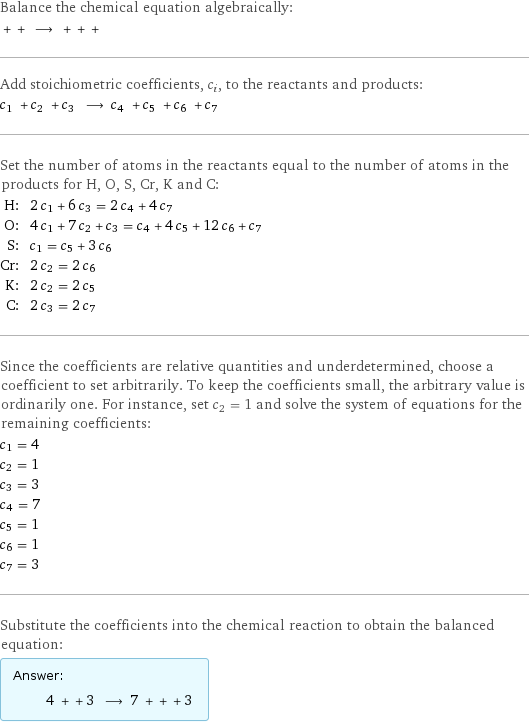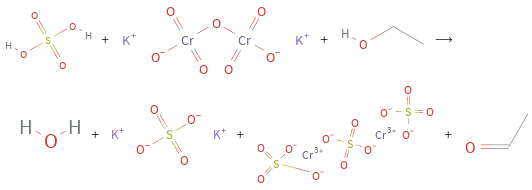Input interpretation

sulfuric acid + potassium dichromate + ethanol ⟶ water + potassium sulfate + chromium sulfate + acetaldehyde
Balanced equation

Balance the chemical equation algebraically: + + ⟶ + + + Add stoichiometric coefficients, c_i, to the reactants and products: c_1 + c_2 + c_3 ⟶ c_4 + c_5 + c_6 + c_7 Set the number of atoms in the reactants equal to the number of atoms in the products for H, O, S, Cr, K and C: H: | 2 c_1 + 6 c_3 = 2 c_4 + 4 c_7 O: | 4 c_1 + 7 c_2 + c_3 = c_4 + 4 c_5 + 12 c_6 + c_7 S: | c_1 = c_5 + 3 c_6 Cr: | 2 c_2 = 2 c_6 K: | 2 c_2 = 2 c_5 C: | 2 c_3 = 2 c_7 Since the coefficients are relative quantities and underdetermined, choose a coefficient to set arbitrarily. To keep the coefficients small, the arbitrary value is ordinarily one. For instance, set c_2 = 1 and solve the system of equations for the remaining coefficients: c_1 = 4 c_2 = 1 c_3 = 3 c_4 = 7 c_5 = 1 c_6 = 1 c_7 = 3 Substitute the coefficients into the chemical reaction to obtain the balanced equation: Answer: | | 4 + + 3 ⟶ 7 + + + 3
Structures

+ + ⟶ + + +
Names

sulfuric acid + potassium dichromate + ethanol ⟶ water + potassium sulfate + chromium sulfate + acetaldehyde
Chemical names and formulas

| sulfuric acid | potassium dichromate | ethanol | water | potassium sulfate | chromium sulfate | acetaldehyde Hill formula | H_2O_4S | Cr_2K_2O_7 | C_2H_6O | H_2O | K_2O_4S | Cr_2O_12S_3 | C_2H_4O name | sulfuric acid | potassium dichromate | ethanol | water | potassium sulfate | chromium sulfate | acetaldehyde IUPAC name | sulfuric acid | dipotassium oxido-(oxido-dioxochromio)oxy-dioxochromium | ethanol | water | dipotassium sulfate | chromium(+3) cation trisulfate | acetaldehyde